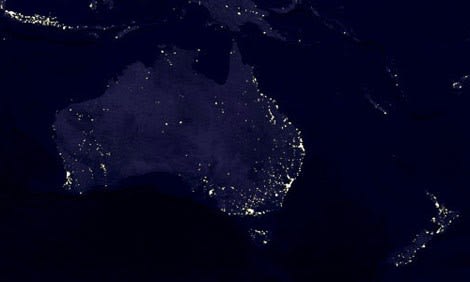Why Australia's population dispersal creates stability in the property market
I love this image as it tells us so much about the world and how the wealth has been dispersed. The lights illustrate the dominance of the Unites States and Europe, in addition to the emergence of India and China as future super powers.

Photo: C. Mayhew & R. Simmon (NASA/GSFC), NOAA/ NGDC, DMSP Digital Archive
When we look at Australia the image can also tell us a lot about the local property market and gives us an insight into why it has been reasonably solid compared to some other countries.
Australia is an enormous country with access to significant mineral wealth. However most of the country is not a palatable place to call home. As a result many Australians decide to live in major cities close to the coast with very few venturing into the middle of the country.

In Australia over 70% of our population live in our 10 biggest cities. This means we have a very centralized market with the majority of people competing for scarce land close to major cities where they are more likely to find stable employment.
Because most of the population wants to live in these defined areas it creates somewhat a housing shortage. But Australia does not have a housing shortage – it only has a shortage of housing in areas where the majority of people want to live.
This competition for a finite commodity puts pressure on the value of land and results in a more robust property market. While the overall market has come back a bit from the highs of 2010, some areas are performing better than others. The property markets that are feeling the effects of a softening market most are the outer-lying suburbs where supply of land is not an issue and job stability is less reliable.
By contrast the image shows that much of the United States has been populated. In the US only 13% of Americans live in the 10 largest cites. They obviously have a much larger population than Australia so have to spread out across the country. But if we take it a step further we find that only 25% of Americans live in the 50 most populace cities. The American market has a more decentralized population and as a result the pressure on the value of land is less.
The US has traditionally had very well established small town communities with schools, transport and entertainment. These small towns often do not have a shortage of land and while this does create more affordable housing it also increases the risk of price volatility.
Many of these small towns have been smashed by falling property prices and unemployment. With the vast majority of the population living in these areas it has had a catastrophic effect on the overall US property market. As a result it will take the US market significantly longer to drag itself out of the doldrums.
While the property market in Australia has been through a natural softening phase, and is not out of the woods yet, the demographic make-up of our population will result in less dramatic falls. As a result some assets will hold their ground and weather the storm and be well positioned for future growth while others will languish for a few years to come.
Mark Armstrong is a director of iProperty Plan, which provides independent analysis and tailored advice to investors and home buyers.